Annotations for Jerusalem by Alan Moore
Book 1 – The Boroughs
Atlantis

General: This chapter is from the point of view of Benedict Perrit, an aging poet, on May 28, 2006. It intersects with several other chapters set on that date. Perrit is closely based on a friend of Alan Moore’s, Dominic Allard. Like Moore/Warren, Allard was born in 1953.
Page 207 – titled Atlantis
- The title is taken from a (never-completed) poem of Perrit’s It is a metaphor for a drowned and inaccessible past. See particularly P237p1-2.
paragraph 1
- “Foul fanthoms five his farter lies, and office bones are cobbles made.” – This is a pastiche of a famous line from Shakespeare’s The Tempest (Act I, Scene 2, lines 397-398), in semi-Joyce-ean language:
397Full fathom five thy father lies;
398Of his bones are coral made;
399Those are pearls that were his eyes:
400Nothing of him that doth fade
401But doth suffer a sea-change
402Into something rich and strange.
-
- “fanthoms” primarily evokes “phantoms”, but also “(comics) fan”, “thorns”, “(doubting) Thomas”.
- “office bones” suggests someone working in a dreary office job.
- The character in Shakespeare has become something “rich and strange” through natural processes of decay. The pastiche of it in this sentence could be taken to indicate that Perrit has decayed into something ludicrous and laughable. While he laughs at himself, the fact that the sentence starts with “Foul” betrays his suppressed negative feelings about his decline.
- “drefting” – The semi-Joyce-ean language continues, evoking the shifting nature of dreams. This word evokes “drifting”, “resting”, and perhaps “drafting”.
- “scrabble crabs” – The movement of crabs is sometimes called “scrabbling”. But there is also an allusion to Scrabble, the popular word game.
- “mermering” – “murmuring”, crossed with “mermaids”.
- “slowmile” – “mobile”. This perhaps encodes the idea that while it is slow to travel a mile, a mobile phone can do it instantly.
- “winkles” – More commonly these days called periwinkles, a kind of small shellfish.
- “tetras” – A kind of small fish. This second mention of a small fish may be meant to bring to mind the phrase “big fish in a small pond”. Perrit himself is more of a small fish in a small pond.
- “tumbled busts” – Can be read as either “knocked-over statuary” or “post-coital mermaid breasts”.
- “dead men’s chests” – Referring to a famous pirate song invented by Robert Louis Stevenson. The chorus goes:
Fifteen men on the dead man’s chest—
…Yo-ho-ho, and a bottle of rum!
Drink and the devil had done for the rest—
…Yo-ho-ho, and a bottle of rum!
paragraph 2
- “a bike smash more than forty years ago” – So, 1966 or earlier.
- “His dad, old Jem, was dead.” – Jem Perrit’s ghost was seen briefly in the chapter Rough Sleepers, P102p3.
- “in Tower Street, what had been the top of Scarletwell Street” – See map.

Ben Perrit’s House (Google Maps 2021)
Page 208
paragraph 1 (continued)
- No notes.
paragraph 2
- “Dylan Thomas” – Welsh poet and writer (1914-1953). Given the Welsh element from the previous chapter, perhaps Moore intended at one point to suggest a connection between Northampton and Wales, similar to the connection with Lambeth.
- “H.E. Bates” – English writer (1905-1974). Born and raised in Northamptonshire.
- “John Clare” – Northampton poet (1793-1864). A major figure in Moore’s novels, he is central to the Voice of the Fire chapter The Sun Looks Pale Upon The Wall, and has significant appearances in the Jerusalem chapters Round the Bend and The Steps of All Saints.
- “Thomas Hardy” – English poet and writer (1840-1928).
paragraph 3
- “Down in Freeschool Street” – South of Marefair.

Camay soap
paragraph 4
- “Camay” – A brand of soap, typically marketed to women.
paragraph 5-6
- No notes.
Page 209
paragraph 1 (continued)
- “Old Spice” – An aftershave brand.
- “It smelled like the ’Sixties” – Which is to say, when Perrit was a teenager.
paragraph 2 – 8
- No notes.
Page 210
paragraph 1 (continued)

- “The Clitheroe Kid” – A BBC radio comedy show that ran from 1957-1972.
paragraph 2
- “hedgehog-baking Gypsy” – Hedgehogs are a traditional Gypsy food.
paragraph 3
- No notes.
paragraph 4
- “Three things, then” – This is starting to feel like a sort of Spanish Inquisition. The joke will continue sporadically throughout this chapter.
paragraph 5 – 7
- No notes.
paragraph 8
- “Benson & Hedges” – A British brand of cigarette.
paragraph 9
- No notes.
paragraph 10
- “a haunted Aboriginal rock outcrop” – Possibly a reference to the 1975 film Picnic at Hanging Rock.
Page 211
paragraph 1 (continued)
- No notes.
paragraph 2

- “A Northamptonshire Garland” – Published in 1989.
paragraph 3

- “Claremont Court” – See image. According to local commenter
jayallard81, this view is actually blocked by its sister building, Beaumont Court. Claremont Court is just north of it. - “Fortean Times” – A magazine “fascinated with the strange and supernatural”. Moore is an avid reader, and has occasionally contributed to the magazine.
paragraph 4
- “Kenny something” – Kenny Nolan, though more generally known as “Fat Kenny”. Previously mentioned in the chapter ASBOs of Desire, and appears as a major character in the chapter The Jolly Smokers.
- “Calpol” – A pain relief medication. I found several articles concerned about small children getting overdoses, but none that seemed an exact match to what this text is talking about.
paragraph 5
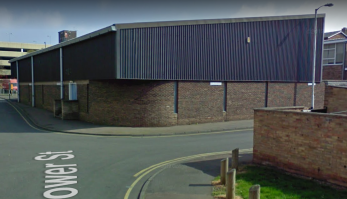
- “lino” – British slang for “linoleum“, a once-popular type of flooring.
- “macadam” – Road surfacing.
- “the Salvation Army building” – See image.
- “tambourines […] brass band” – The Salvation Army used to attract attention with marching bands.
Page 212
paragraph 1 (continued)

- “Brooke Bond” – An English tea brand.
- “navy blue serge and big golden buttons” – Traditional Salvation Army uniform; see image.
- “I’m Not In Love” – A song by British pop group 10cc, released in 1975. The song has been covered several times, including one (by Olive) in 2000, which might well be the version heard now, in 2006.
- “The short street ended as it met the footpath to the underpass, where a high wall reared up” – This is a bit confusingly worded, but the high wall (not that high) is at the end of Tower Street. The “underpass”is the entrance to the subway which Marla passed in the chapter ASBOs of Desire, P85p3; it’s about a block south of Tower Street, by which point the wall has shrunk to almost nothing.
- “Patterned with a bar-code stripe of ochre, tangerine and umber” – This is referring to the walls of the underpass/subway entrance, and is sadly accurate; see image below. Perrit apparently can see the underpass from here, but he won’t actually reach it until P212p3.

Footpath passing subway entrances (Google Street View 2009)
paragraph 2
- “the Jolly Smokers” – Significant throughout Jerusalem, particularly in the chapters Forbidden Worlds and (naturally) The Jolly Smokers. Its site was in fact very close to where Perrit is now; see map.

Ben Perrit’s walk, part 1 (Google Maps 2021) - “historian Henry Lee” – I have not yet been able to identify this person. Suggest??
- “Richard the Second” – King of England 1377-1400. He confirmed the earlier royal charters (and added details of his own) in 1385.
- “Caffè Nero” – A coffee shop at the corner of Abington Street and Dychurch Lane. Alma Warren will walk past it in the chapter A Cold and Frosty Morning. It’s a bit over a quarter mile east-southeast of where Perrit is now.
- “emetic” – vomit-inducing.
paragraph 3
- “Parliament had placed Northampton under the control of an all-powerful mayor and council” – historyofparliamentonline.org says:
In 1489, following ‘great divisions, dissensions and discords’ during the annual elections of the mayor and other officials, an Act (5 Hen. VII, c.31) provided that the mayor and his brethren (the former mayors, sometimes known as aldermen) should choose 48 of ‘the most wise, discreet and best disposed persons of the inhabitants … other than afore that time have been mayors or bailiffs’ to take part in the election of the mayor and the two bailiffs.
- “tradition of electing a joke mayor” – I have so far been unable to document this tradition (in Northampton or Leicester). Suggest??
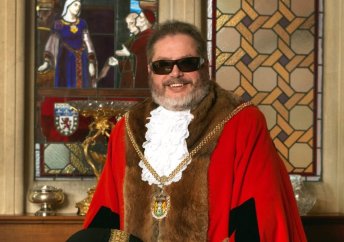
Christopher Malpas wearing Northampton Mayoral chain of office in 2016 (Picture: John Roan) - “chain of office” – Many UK Mayoral positions do come with an elaborate ceremonial “chain of office”.
- “half cut” – British slang “rather drunk”.
- “half sharp” – British slang “stupid”.
- “his own paternal grandfather, Bill Perrit” – Presumably the father of Jem Perrit, whose ghost we saw in the chapter Rough Sleepers. Approximately based on the real-world Bill Allard (see picture below). From In Living Memory:
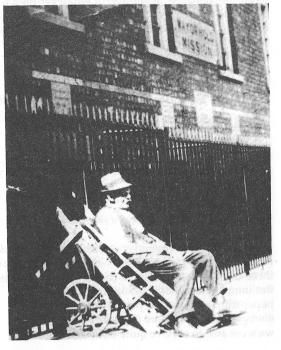
“The Sherriff” outside the Mayorhold Mission (from In Living Memory) Jim Allard: […] They’d call my father ‘The Sherriff’.
Richard Foreman: Why?
JA: Because he was so domineering. Wanted everything doing his way. He used to sit for hours on the Mayorhold, on a handtruck. […]
Eileen Allard : His name (was) Bill Allard.
Page 213
paragraph 1 (continued)
- “Titchbourne Claimant” – A famous English legal case in the 1860s and 1870s, in which a man claimed to be the missing heir to a baronetcy. (There’s some typos here; the correct name is “Tichborne”.)
- “Great Pretender” – The capital letters suggest that this may be a reference to the 1955 song.

An illustration of Lambert Simnel riding on the shoulders of supporters in Ireland (en.wikipedia.org) - “Lambert Simnel” – A pretender to the throne of England in 1487.
- “Perkin Warbeck” – A pretender to the throne of England from 1490-1497. These two pretenders and their associated rebellions were arguably the last part of the Wars of the Roses.
paragraph 2

- “Even from this low vantage” – See image.
- “the Spanish-omelette tiling” – Another colorful phrase for the unfortunate color scheme of the underpass.
- “the dyke wall” – Possibly some sort of pun on dike/dyke? In the chapter Rough Sleepers (P92ff), we learned that some lesbians used to have fights in this neighborhood.
- “Bedford Housing” – Possibly an invented name to avoid potential lawsuit. In the real world, the two buildings were sold to the Leicester Housing Association in 2004.
- “there’d been calls to tear the barely-habitable monsters down, acknowledgements that they should never have been put up in the first place” – I haven’t found any more details on this yet. Suggest??
- “for what was reputedly a penny each” – The actual price appears to have been one pound for the pair. If one considers that one pound divided up among the 140 apartments, that comes to less than one penny per apartment.
- “Key Workers” – Key Worker housing was apparently a hot issue in 2004. A BBC article about the purchase stated:
Over recent years the Spring Boroughs area has become notorious for crime and prostitution.
The association will reserve 48 of the flats for occupation by key workers.
It is hoped the blocks’ transformation will kickstart the regeneration of the area.
paragraph 3
- “Roman Thompson” – Appeared briefly in the chapter ASBOs of Desire, and is the main character of the chapter Burning Gold.
- “James Cockie” – Viewpoint character of the chapter Cornered. I have been unable to substantiate the implication of corruption here.
paragraph 4
- No notes.
Page 214
paragraph 1 (continued)
- “a head-and-shoulders sketch by Boz” – Presumably referring to Sketches by “Boz,” Illustrative of Every-day Life and Every-day People by Charles Dickens, originally illustrated by George Cruikshank. None of those illustrations, however, is “head-and-shoulders”. Possibly the “by Boz” is just Perrit free-associating.
- “a previously forgotten dream” – We will see Cockie’s version of this in the chapter Cornered, Pxxx.
paragraph 2
- “Spring Lane School” – The elementary school both Perrit and Alma Warren attended, on the north side of Scarletwell Street.
- “what still seemed like somebody else’s nightmare” – Which, for most practical purposes, it was.
- “Silver Street” – This name is rather an anachronism. There used to be a Silver Street in roughly this location, but the area was rebuilt sometime between 1950 and 2009. The new street here is named Greyfriars, though it wouldn’t surprise me if older people (like Perrit) still referred to it as Silver Street. The fact that he mentions “Silver Street” meeting Sheep Street a few paragraphs on is what makes me sure this is not Silver Street, which never intersected Sheep Street, While Greyfriars does.
paragraph 3
- “there rose the five-floor municipal car park” – See image.

“there rose the five-floor municipal car park” (Google Street View June 2018) - “Battenberg” – A type of British sponge cake with alternating red and yellow sections.
- “Co-operative Society, Built 1919, Branch Number 11” – In Living Memory does have a (poor quality black & white) photo of a building with signage “NORTHAMPTON COOPERATIVE SOCIETY Ltd” “BRANCH No.11” “BUILT 1919”. While the only photo of this building I’ve found is in black and white, other buildings owned by the Co-op, built in a similar style, did have a green and white color scheme.
- “Georgie Bumble’s Office” – See the chapter Rough Sleepers, P103ff.
- “Electric Light Working Men’s Club” – An odd name, perhaps dating from a time when electric lighting was a novelty. Working Men’s Clubs are something between a social club and a pub.
- “Bearward Street” – This street no longer exists; the parking garage is atop most of its former length.
Page 215
paragraph 1 (continued)
- “four-by-fours and Chavercrafts” – A “four-by-four” is a vehicle with four wheel drive. Such a vehicle is almost by definition a statement of masculinity, as such power is certainly not necessary in Northampton’s gentle terrain and climate. “Chavercraft” is an original portmanteau of “chav” (a working-class young man with poor taste) and “hovercraft”.
- “The backside of the old Fish Market stood upon his right” – While this is true, I don’t think it would have been visible from here; Perrit is just remembering it as a notable older building nearby. The Fish Market building was demolished sometime between 2012 and 2014, replaced by the North Gate Bus Station.
- “erected on the synagogue” – Approximately true. http://www.jtrails.org.uk/ has considerably more detail about the exact position of the synagogue.

A Ford Transit on Sheep Street (Google Street View Oct 2012) - “Ford Transit Gloria Mundi.” – A pun combining “Ford Transit” and the classical Latin phrase “Sic transit gloria mundi”. Ford Transit is a brand of cargo van which Google Street View shows to often be present on Sheep Street. The Latin phrase means “Thus passes the glory of the world”. It is usually used as a reminder of mortality and transitoriness, important themes throughout Jerusalem.
paragraph 2
- “the brick wall near the Chinese restaurant” – Presumably Oriental Garden, present from at least 2009-2021. Since he hasn’t yet turned into Sheep Street, this must refer to the brick wall to the north of the restaurant, so Perrit has wandered across the restaurant’s (then) parking lot, possibly to get a closer look at the flower mentioned just after this.

Oriental Garden mural (Google Street View Nov 2020) - “in the face of a deflowered and drab MacCentury” – MacCentury parodies Apple corporation’s habit of product names such as “MacAirbook”. This meditation on drabness at this location would become more difficult to imagine sometime between 2019 and 2020, when a colorful mural was painted on the brick wall, and the parking lot was mostly replaced with grass and garden.

Ben Perrit’s walk, part 2 (Google Maps 2021) - “The force that through the green fuse drives …” – The beginning of a famous 1933 poem by Dylan Thomas. It touches on the moral ambiguity of nature and the transitory nature of life.
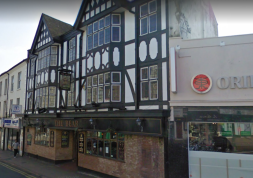
The Bear (Google Street View Apr 2009) - “the Bear” – An old pub on Sheep Street, still there as of 2021. Part of its cellar was part of the old synagogue.
paragraph 3
- “fruit machines” – British for “slot machines“.

The Bear noisy interior Nov 2019 (Photo by Neil Freeman) - “the squelch of crazy frogs” – Possibly a reference to the videogame Frogger, though the game would be a quarter-century old in 2006. As of 2021, there exist many many variations of a game sometimes called “Crazy Frog” which seems similar to Whac-a-Mole.
- “dominos” – A traditional pub game.
paragraph 4

- “Hello, me old pal, me old beauty” – The catchphrase of Walter Gabriel (see below).
- “Archers” – The Archers is a popular BBC radio drama, running from 1951 to at least 2021, and still going!
- “Walter Gabriel” – One of the original main characters of The Archers, played by Chris Gittins from 1951 to 1988, when he died. In 2006, he would have been dead for 18 years.
paragraph 5 – 8
- No notes.
paragraph 9
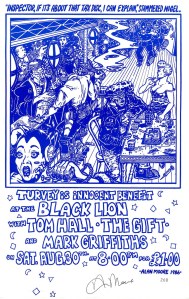
- “Dave Turvey” – Only mentioned in this chapter. Based on a real Northampton resident of the same name, who was for a time landlord of the Black Lion pub. When he was arrested in 1986 on drug charges, Alan Moore drew a poster for a benefit concert. (Many thanks to commenter Steve for this info!)
Page 216
paragraph 1 (continued)
- “Dodge City” – Famous frontier city of the American Old West.
- “Bad Friday” – Presumably as opposed to the Christian holiday Good Friday.
- “John Smith’s” – A brewery in North Yorkshire.
- “sepia Darwin” – The back of a ten-pound note in 2006 featured an image of Charles Darwin and a hummingbird. This design was retired in 2016.

Ten Pound note (https://en.numista.com/) - “Hypnoscope” – A (largely fictional) device to hypnotize someone. This refers to a hologram situated in the scientific instrument the hummingbird is looking at.
- “Farewell […] I hardly knew ye” – An idiom derived from an Irish song of 1867, “Johnny I Hardly Knew Ye“.
paragraph 2
- “slate-blue Elizth. Fry” – The five pound note in 2006 had a picture of Elizabeth Fry on the back. Fry (1780-1845) was a prison reformer.

Five pound note (https://en.numista.com/) - “what looked like a nineteenth-century battered woman’s refuge” – The actual scene is of Fry reading to inmates of Newgate Prison.
- “the disapproving spectre of John Lennon” – A humorous anachronism, as Lennon is very much a 20th century figure. John Lennon is famous for having worn round glasses with very thin rims, like the man at the far left of the image.
- “Dads For Justice” – Probably referring to Fathers 4 Justice, a protest group in favor of fathers’ rights. Founded in 2001, they seem to have gone quiet after 2016. They were known for publicity stunts in outlandish costumes, hence Perrit’s reference to “fancy dress”.
- “shrapnel” – A surprisingly violent image for referring to loose change.
- “the old money, all the farthings, half-crowns, florins, tanners” – The UK converted to decimal currency in 1971 (when Perrit was 18), leaving behind an extremely eccentric monetary system. A farthing was worth one-quarter of a penny. A half-crown was worth one-eighth of a pound. A florin was worth one-tenth of a pound. A tanner was worth six pennies. And these are just a few of the many coin denominations!
paragraph 3
- “cheese and pickled onions” – Traditional ingredients of a Ploughman’s Lunch, which also included beer.
- “Park Drive” – A UK brand of cigarettes. The “pink” designation refers to the packaging of the unfiltered cigarettes. (The filtered variant of Park Drive was sold in blue packaging.)
- “the Black Lion” – Northampton has two “Black Lion” pubs; since Perrit doesn’t use the word “Old”, he probably means the Black Lion on St. Giles Street (see P234p3 below).
- “Precambrian” – The geological period between the formation of the Earth and roughly 541 million years ago.
- “He put down the half-empty glass, trying to kid himself that it was still half full” – Riffing on the old saw that an optimist sees the glass as half-full, while a pessimist sees it as half-empty.
paragraph 4
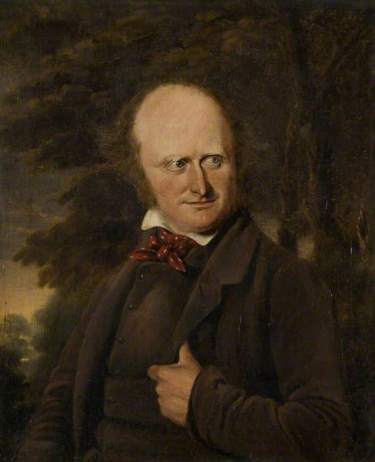
- “Thomas Grimshaw’s 1840s portrait of John Clare” – See image. John Clare, a Northampton poet of the nineteenth century, is an important figure to Moore, being the viewpoint character of the Voice of the Fire chapter The Sun Looks Pale Upon the Wall, and having significant appearances in Jerusalem in the chapters Round the Bend and The Steps of All Saints.
- “Humpty Dumpty” – A character that dates back at least to 1797. Probably most famous today via his appearance in Lewis Carroll’s Through the Looking-Glass.
- “Andrew’s Hospital” – The asylum in which Clare spent the last 23 years of his life. See the chapter Round the Bend for more details.
Page 217
paragraph 1
- “Helpston” – Helpston is a village in Northamptonshire where Clare was born, and where he spent his early life.
- “Glinton” – A village in Cambridgeshire, where Mary Joyce (Clare’s first love) lived.
- “Stars In Their Eyes” – A British TV talent show which ran from 1990-2006. The host always entered through a cloud of dry ice fog.
paragraph 2

- “a discoloured slug, fired from a price-gun” – A price-gun is a device for quickly applying price labels. Perrit is comparing the label to a bullet from a firearm, though “discoloured slug” also evokes a garden pest.
- “fifteen years ago” – So, circa 1991.
- “where Waterstone’s was now” – Probably referring to the Waterstone’s in Abington Street, which has been there since at least 2016. It’s about half a mile’s walk southeast from his mother’s house.
- “Adnitt’s” – A department store located in the Drapery, later replaced by Debenhams. Previously mentioned in the chapter Modern Times, P152p2.
- “one-and-thrupenny” – One shilling and three cents. In modern currency, 15 cents (about the same in American money). Presumably these were either used or remainders, as new pulp novels during Perrit’s youth would have been priced at least double that.
- “the upper and the lower branch of Woolworth’s” – Woolworths was the name of a popular retail chain store that operated in the UK between 1909 and 2009. As mentioned in the chapter Work in Progress (P3p1), there were two branches in Northampton, only about a half a mile apart!

A sampling of early 70s Orpheus Original covers - “yellow-covered 1960s pornographic classics” – Possibly referring to the Orpheus Original imprint of Bee-Line books. At least during the early 1970s, their books all had yellow covers; see image. But see next note for other possibilities.
- “Jaundiced Aubrey Beardsley nudes” – “Jaundiced” is a here a decadent way of saying “yellow”. Aubrey Beardsley was an important 19th century artist, whose work was often erotic. He was an editor of the magazine The Yellow Book. Per Wikipedia, “The Yellow Book‘s brilliant colour immediately associated the periodical with illicit French novels”.
- “Technicolor” – Technically, a set of processes for making color film, used widely as advertising term in the 1950s. Here, it’s a poetic way of saying “brightly colored”.

A typical Hank Janson cover - “Hank Janson” – A fictional reporter/detective (and the pseudonymous author of his books). He starred in over 200 novels from the late 40s through the late 60s. The covers almost always featured an image of a highly-sexualized woman. The covers were brightly colored, and often made significant use of the color yellow (see above).
- “Dennis Wheatley” – 20th century English horror writer. Moore used his name in Providence, most significantly in issue 4. Moore had a “spate” of reading Wheatley around age 12; by 2011 he tended to denigrate Wheatley, but was still interested enough to read (and blurb) a biography of him.
- “Simenon” – Georges Simenon, a prolific 20th century mystery writer. Many of his book covers featured his name merely as “SIMENON”, often in larger lettering than the title.
- “Alistair MacLean” – A 20th century adventure writer.
paragraph 3
- “half a gill with eight sips to the pint” – A gill is an archaic unit of measure, and is equal to a quarter of a pint.
- “amethyst” – A poetic way to describe purple plastic.
- “Clock-a-Clay” – a poem by Clare written while in the asylum, sometime between 1842-1864.
- “ladybird” – AKA “ladybug”.
Page 218
paragraph 1 (continued)
- “I Am” – Perhaps Clare’s most famous poem, commenting bleakly on his alienation. It is three stanzas long; the middle stanza is included just below.
paragraph 2
- “the dearest that I loved the best” – For Moore, this has to be considered to include Mary Joyce. See the chapter The Steps of All Saints, Pxxx for more on this.
paragraph 3
- “holed below its waterline” – Continuing the shipwreck metaphor from the poem. A ship with a hole below its waterline will soon sink if not quickly repaired.
- “exposed his queen, Elizth. Fry, precariously” – For more on Fry, see note at P216p2 above. Calling her a “queen” may be conflating her with the front of the note, showing Queen Elizabeth II, or may be a chess metaphor.

Five pound note (https://en.numista.com/)

paragraph 4

- “Shipman’s” – A pub about two blocks south of the Bear. The building is extraordinarily narrow; see image.
- “Drum Lane” – An alley small enough to not be marked by Google Maps. Perrit has walked out the back exit.
- “pasty” – A sandwich-like food item popular in England. Pastry around a filling of vegetables and (usually) some meat.
paragraph 5
- “serviette” – British “paper napkin”.

Ben Perrit’s walk, part 4 (Google Maps 2021) - “the most recent shopping arcade, Peacock Place” – By 2016, this had in turn been replaced by Market Walk.
- “Peacock Way” – Not on the map from 1950, so presumably was at least fairly new during Perrit’s teenage years.
Page 219
paragraph 1 (continued)
- “Notre Dame” -An all-female Catholic school in Northampton between 1880 and 1975. It seems to have been located a few blocks down Abington Street from Perrit’s current location. See image below.

Notre Dame 1964 (https://www.youtube.com/watch?v=mob6rxDJLzo) - Derngate” – Northampton High School, another all-girl school, founded in 1877. Though it has since moved, it was formerly located on Derngate Street, about three blocks south of Perrit’s current location.

Peacock Hotel in the 1950s (www.northamptonchron.co.uk) - “Peacock Hotel […] senseless demolition in November 1959” – According to Northampton Chronicle & Echo, the hotel was demolished in 1960. A different article suggests that the shopping centre was built “in the eighties.”
- “a pallid stick-on imitation” – Even this remnant seems not to have survived the transition from Peackock Place to Market Walk.
paragraph 2
- “Jessop’s, the photography equipment shop” – Jessops (no apostrophe) is a British company. While they still exist as of 2021, they (like many photo companies) have fallen on hard times. The Northampton branch moved further down Abington Street sometime prior to 2009, and seems to have permanently closed sometime between 2014-2015.

“Piet” Corr self-portrait (https://www.saatchiart.com/pietdesnapp) - “Pete Corr” – A real person, who died in 2018. He took several pictures of Alan Moore.
- “posing moodily in sunglasses and leather jacket” – Strangely, I can find no such photos of Moore. Searches for them easily turn up Neil Gaiman wearing such outfits though!
- “mutton dressed up as Olivia Newton-John” – Suggest??
- “Tom Hall” – A good friend of Moore’s, he appears as a supporting character in the chapter Forbidden Worlds, Pxxxff. (Also a friend of Dave Turvey’s, see note at P215p9.)
- “tasselled hat swiped from the Ottomans” – AKA a fez.
- “the eight-hundred-year-old beech” – See the chapter The Rafters and the Beams, Pxxx.
paragraph 3
- “pink, pedestrianised” – Part of Abington Street was pedestrianized in 1984. (A further part was pedestrianized in 1995, but de-pedestrianized in 2014.) Some of the brickwork could be described as pink.
- “at least five hundred years” – A version of Abington Street is visible on the 1614 map.
- “Wellingborough Road” – A road that leads roughly east off the far end of Abington Street.
- “Abington” – Here referring to the district of that name, about a mile ENE of Perrit’s current location.
paragraph 4
- “Grosvenor Centre” – Another shopping mall.
- “Wood Street, which had occupied the spot some thirty years before” – On the 1950 map, Wood Street runs from Abington (just across from Fish Street) north to Lady Lane. Grosvenor Centre opened in 1976, exactly 30 years prior to this chapter.
- “terraced” – Here probably referring to “terraced houses“, known in the US as townhouses or row houses.
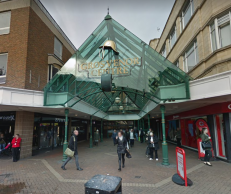
Grosvenor Centre entrance (Google Street View Oct 2016) - “the sparkling covered boulevard” – Possiby the same one that was there in photos dating back to at least 2013 (see image), but which came down some time between 2017 and 2018.
paragraph 5
- “Mars Bar” – Caramel and nougat covered in milk chocolate.
- “top Woolworth’s” – As detailed in chapter Work in Progress (P3p1), there used to be two Woolworths (no apostrophe) in downtown Northampton. in 2009, Woolworths went out of business.
Page 220
paragraph 1 (continued)
- “Marks & Spencer” – A popular British department store. At least as far back as 2016, a branch was located across the street from the former site of Woolworths; probably it was there in 2006 for Perrit to notice it.
- “pissed” – British “drunk”.
paragraph 2
- “the wide-angle Art Deco front of the Co-op Arcade, abandoned and deserted” – The building is quite wide; see image below. By 2015 at least, there were stores on the ground floor once more.

Former Co-op Arcade (Google Street View Aug 2015) - “Spinadisc” – This record store seems to have moved several times, but I have found a photo which I am pretty sure is across from the former Co-op Arcade.

Spinadisc storefront (www.britishrecordshoparchive.org) - “a rehab centre” – The earliest Google Street View we have of this area is 2015, by which time there does not appear to be any rehab centre among the storefronts.
paragraph 3
- “public seating” – Photos from 2015-2020 all show a bench nearby, though it moves around, and may not be the same that was there in 2006.
- “skate-goths” – The intersection of skateboard culture and goth culture (about which, see chapter The Rood in the Wall for more).
- “gangsta-romantics. Happy-stabbers or whatever. ” – “Gangsta” (slang for gangster) is a subculture associated with rap music and crime. As far as I know, “gangsta-romantics” and “Happy-stabbers” are both invented by Perrit, combinations of youth cultures that you wouldn’t normally think would have much overlap.
- “murder of hoodies” – Perrit is applying the collective noun for crows to the black-clad youths. In 2006, hoodies were the subject of much controversy, often associated with crime.

paragraph 4
- “when they were four” – 1957.
Page 221
paragraph 1 (continued)
- “Freeschool Street” – Also the location of Perrit’s childhood home, in the SW corner of The Boroughs.
- “flying saucer” – An early term for UFO. They were ubiquitous in pop culture of the 1950s.

Fallen to the communists? - “she’d just fallen to the communists” – The late 60s was the height of the Cold War, when concern about countries “falling to the communists” was common. Moore is on the far left politically, and has been accused of being a communist. A 1987 picture of Moore shows him wearing a hammer-and-sickle T-shirt.
- “stencil-duplicated” – AKA mimeographed. A low-quality but low-cost reproduction system commonly used from roughly 1900-1975.
- “arts-group” – Probably referring to the Northampton Arts Lab, which Moore was involved in during the early 1970s. (Moore started a new Northampton Arts Lab in 2016.)
- “a fifteenth-century nun” – While I have no evidence that Moore wore anything much like this, he has certainly been known to dress oddly.

Moore displaying rings under his eyes and on his fingers (vanishingpointchronicles.com) - “more rings underneath her eyes than on her ostentatiously embellished fingers.” – See image. Starting in the late 90s(?), Moore habitually wears elaborate rings on all ten fingers.
paragraph 2
- “arterial spatter” – Poetic phrase for spray of blood, resonant with slasher movies, or their stage forbear, Grand Guignol.
- “fire-curtain” – A fire-resistant safety curtain, usually used in large theaters.
- “pantomime” – In the UK, a pantomime is a musical comedy play, usually associated with children and holidays.
- “kohl” – An ancient, dark makeup, used as both eye-shadow and mascara. This is probably Perrit being poetic again, but with Alma, it might be literal.
- “fog lamps” – Extremely bright lamps for cutting through fog, usually on cars. Here, poetic for Alma’s eyes with their piercing gaze.
- “anthracite” – A hard variety of coal. Per Wikipedia, it has a “submetallic luster“.
- “Carmine” – A purplish-red color.
paragraph 3 – 4
- No notes.
Page 222
paragraph 1 – 2
- No notes.
paragraph 3
- “Lothario” – A name meant to indicate an unscrupulous seducer. Originally from Don Quixote.
paragraph 4 – 6
- No notes.
paragraph 7
- “Clearance Area” – This is a poem by Dominic Allard.
paragraph 8 – 12
- No notes.
Page 223
paragraph 1 (continued)
- “The Independent” – A British newspaper.
paragraph 2
- No notes.
paragraph 3
- “flue-brush” – A thick brush for cleaning chimneys. A poetic way of saying that Alma has very thick eyelashes.
paragraph 4 – 16
- No notes.
Page 224
paragraph 1 (continued)
- “the nursery that used to be Pitt-Draffen’s dance school” – “Pitt-Draffen’s dance school” is still in existence in Northampton, but has moved out of the Boroughs. In a 2016 interview, Moore identified the site as “the Christ Disciples Faith Ministry. Back in 2006, before some remodelling, this was the day-care nursery where Alma decided to stage her exhibition”.
paragraph 2 – 6
- No notes.
paragraph 7

- “Cyberman” – Punning on “cyber café”. The Cybermen are popular nemeses of Doctor Who. They would have been much in the public consciousness as they had been brought back for the revived series just 15 days prior to this chapter.
paragraph 8
- Perrit is looking at the back of a twenty pound note, the design being the one used from 199-2007.

Twenty pound note (www.rankcurrency.com) - “Worcester Cathedral” – A major Anglican cathedral. Edward Elgar (see below) lived nearby and is associated with it.
- “cosmic ray-storm” – Possibly a reference to the famous cosmic ray storm that gave the superheroes The Fantastic Four their powers.
- “St. Cecilia” – Patroness of musicians.
- “Sir Edward Elgar” – 1857-1934, a famous English composer, best known for Pomp and Circumstance Marches.
- “The Dream of Gerontius” – An orchestral work of Elgar’s from 1900. Relating to the themes of Jerusalem, it tells of a man’s death, judgment, and arrival in Purgatory.
- “pastoral” – Here used primarily in the sense “relating to pastors” or “religious”. But pastoral is more commonly used as “relating to nature” (a poetic extention of “relating to shepherds”).
paragraph 9
- No notes.
Page 225
paragraph 1 (continued)
- “Abington Square” – The “square” runs roughly from the former gate to the junction of Abington Street, Kettering Road, and Wellingborough Road (see maps below).
- “Emmerdale” – A long-running British soap opera. The opening theme can be heard here.
paragraph 2

- “the east gate of the town” – More properly the northeast gate.
- “they’d called Edmund’s End back in the eighteen-hundreds” – Even earlier; the map from 1614 labels what is currently Abington Square as “S. Edmonds end”.
- “St. Edmund’s Church” – Built in 1850, torn down in 1980 (26 years before this chapter).

the gorgeous 1930s cinema (Google Street View Apr 2009) - “the gorgeous 1930s cinema” – See image.
- “ice-lolly” – In America, “popsicle”.
- “Jesus Army” – A real organization, much as described here. It shut down in 2019, following accusations of sexual assault during the 1970s.
- “Bugbrooke” – A village about seven miles southwest of Northampton.
- “happy clappy” – A derogatory term referring to Evangelical Christianity.
- “bindweed” – An invasive plant that is difficult to root out.

Jesus Army bus (photo: Martin Pettitt 11 July 2009) - “rainbow-liveried buses” – See image.
- “tramp-grabs” – The Jesus Army did much work with homeless people. Perrit’s description makes it sound more like kidnapping.
- “Cromwell” – See the chapter (and notes to) Sleepless Swords, Pxxxff.
paragraph 3
- Perrit is now on Wellingborough Road.
- “The slipper factory” – I haven’t been able to find any info about this; suggest??
- “Guy Salmon” – A real dealership. They were still in existence as of Nov 2020, but may have closed since.
- “Irish Centre” – I’m not sure what an Irish Centre did (suggest??), but it was operating in this site from 1977-2002.
- “Urban Tiger” – A high-end strip club, opened in 2002, still operating.
- “angry Tamils learning martial arts” – Punning on the Tamil Tigers, violent revolutionaries in the Tamil region of Sri Lanka.

paragraph 4

- “Charles Bradlaugh” – Charles Bradlaugh, MP. This statue appeared previously in the chapter “Blind, But Now I See” (P177p2-3) and the final chapter of Voice of the Fire.
- “teetotal” – A somewhat old-fashioned word for someone who abstains from alcohol. I have been unable to locate anything about Bradlaugh’s views on alcohol. However, his wife Susannah “became a compulsive alcoholic”.
- “the Workhouse” – This establishment may have moved between 2006 and 2009, or Perrit’s description may be misleading. As of 2009, there was no pub across from the Bradlaugh statue. There was a pub called The Workhouse on the right of Wellingborough Road, a few blocks after the Bradlaugh statue (see map above, and image below). Sometime between 2012 and 2014, it changes names (and possibly management). By 2016, the site is no longer a pub at all.

The Workhouse (Google Street View Apr 2009) - “Edmund’s Church” – See P225p3 below.
Page 226
paragraph 1 (continued)
- “Edmund’s Hospital” – St. Edmund’s Hospital was closed in 1998. Over the next two years, part of the building was knocked down to make way for new construction.
- “Northampton’s workhouse” – Its full name was the Northampton Union Workhouse. Workhouses were a Victorian institution intended to deal with extreme poverty. Largely remembered today for how Charles Dickens protested their inhumane treatment in A Christmas Carol.
- “Eichmann” – Adolf Eichmann (1906-1962) was infamously one of the organizers of the Holocaust.
paragraph 2
- “travelling at quite a pace” – See map below.
- “wuthering” – Old word for “making a rushing sound”. Now mostly known from the novel Wuthering Heights.
- “the abandoned hulk of Edmund’s Hospital” – See image below.

“the abandoned hulk of Edmund’s Hospital” (Google Street View Apr 2009) - “filled with ghosts” – I have not found any mentions of specific ghost folklore involving this building, though photos of the interior are certainly spooky. Suggest??
- “asylum seekers” – Again, I have found no references to these, though their presence would be plausible. Some news articles do refer to the hospital as having been an “asylum”, which might be the source of the association.
- “electrode-happy” – That is, torturing.

paragraph 3
- “St. Edmund’s Church” – Built in 1850, torn down in 1980.

“an empty yawn of green with intermittent tombstones” (Google Street View Apr 2009) - “carious” – Decayed. Usually used of teeth, but Moore uses it to refer to stone a few times throughout Jerusalem. Here, of course, Perrit continues an extended metaphor of tooth decay.
paragraph 4
- “Girl’s Grammar” – Possibly what is now the Northampton School for Girls, possibly the “Derngate School” mentioned above (P219p1).
- “Androgyne” – In a 2007 interview, Moore stated:
Myself and a couple of other kids of my age, some from the grammar school that I attended, some from the girls’ schools, we decided spontaneously to put together a magazine of bad poetry basically. It was called Embryo, it was originally going to be called Androgyne, but I found that I couldn’t fit that lettering onto the cover so I shortened it. It was very ramshackle.
- “stencil” – That is, mimeographed.

“wonky stencil illustration” from Embryo issue #2, Dec 1970 - “curate’s egg” – Largely British idiom for something whose good parts are outnumbered by its bad parts.
- “fifth-form” – In the English school system of the 1970s, the school year covering 16-17. For Perrit and Alma Warren, this would have been 1970-1971.
- “the Boy’s Grammar School” – Probably the Northampton School for Boys, on Billing Road, about 2/3 of a mile ESE of Perrit’s current location.
- “the distance […] between the two establishments” – The Boy’s school is about 2 miles south of the Girl’s school.
- “futurist […] romanticism” – Two very different schools of art.
paragraph 5
- No notes.
Page 227
paragraph 1 (continued)
- “Olympus” – The home of the Greek gods; by extension, any “pantheon” of very highly respected figures.

Bridget Riley poster, 1971 (www.invaluable.com) - “Andy Warhol” – (1928-1987) American pop artist, known for iconoclastic work.
- “Bridget Riley migraine art” – Riley (1931-) is an English painter of op art. Her work was often described as “headache-inducing”.
- John Clare” – See notes at P202p2, above.
paragraph 2
- “Spread Eagle” – A pub, see map below.
- “Stimpson Avenue” – See map below.

Ben Perrit’s walk, part 9 (Google Maps 2021) - “Clare, who’d hobbled eighty miles from Essex back home to Northamptonshire” – This event is much of the subject matter in the Voice of the Fire chapter, The Sun Looks Pale Upon the Wall.
- “Abington Park” – About a third of a mile NE of Perrit.
- “Crown & Cushion” – See map above.
paragraph 3
- “Lily” – Perrit’s ex, not mentioned since P202p2.
- “Jolly Wanker” – See notes at chapter ASBOs of Desire, P79p2.
- “Vole & Astrolabe” – A fanciful pub name invented by Perrit. A vole is a small rodent. An astrolabe is an astronomical device.
- “Chronicle & Echo” – I have been unable to discover any mention of Dominic Allard in the Chronicle & Echo. Several of his poems did appear in a BBC competition in 2004.
- “piano-stopping gunfighter” – In old western movies, it was a cliche that a gunfighter would enter a saloon, and all conversation (and the piano) would immediately stop, as everyone turned to look at him.
paragraph 4
- No notes.
Page 228
paragraph 1 (continued)

- “Sir Malcolm Arnold” – English composer (1921-2006). He appears as a character in the chapters Round the Bend and The Jolly Smokers, which depict most of the rumors summarized here as being true.
- “orchestral arranger of such hits as “Colonel Bogey”” – Note that this does not say composer. Arnold used the pre-existing Colonel Bogey March as part of his award-winning soundtrack to the film The Bridge on the River Kwai.
- “Tam O’ Shanter” – A famous 1790 poem by Robert Burns, turned into a musical piece by Arnold in 1955. The subject matter is as described.
- “Wild Hunt” – A widely varying European folklore motif, about supernatural figures hunting unfortunate mortals.
- “Director of the Queen’s Music” – The actual title of the position was “Master of the Queen’s Music“. As detailed in the notes to the chapter Round the Bend, Arnold was considered for this position, but did not get the appointment.
- “Poet Laureate” – A poet greatly honored by a government or institution.
- “joanna” – Cockney rhyming slang for “piano”.
- “ambisextrous” – A portmanteau coined by Perrit of “ambidextrous” and “bisexual”. In the chapter Round the Bend, Arnold describes himself similarly as “ambidickstrous”.
- “djinns and tonics” – Punning on the popular cocktail gin and tonic. Possibly with a pun on “tonic” in its musical sense.
paragraph 2
- No notes.
paragraph 3
- “Victoria Road” – Off of Wellingborough road, about half a mile to the west of the Crown & Cushion.

A record of the 1953 Under Milk Wood performance (https://oldthing.de/) - “Dylan Thomas reading Under Milkwood” – See notes at P208p2. Under Milk Wood (note the space) is a radio drama written by Dylan. The first recorded performance of it, in 1953, did feature Dylan as part of the cast.
Page 229
paragraph 1 (continued)
- “Dansette” – A British brand of record players, tape rcorders, and radios.
paragraph 2
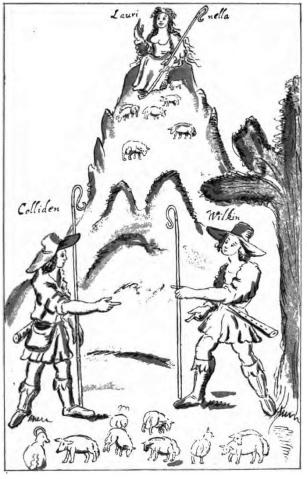
- ““The Angler’s Song”, a work by William Basse” – William Basse (1583-1653?) was an English poet. “Angler’s Song” (no “The”) is a poem about fishing.
- “disputed although likely origins here” – Per Wikipedia, “R. Warwick Bond has suggested that Basse may have come […] from Northamptonshire”.
paragraph 3
- This is the first stanza of “Angler’s Song”. The orignal has “pleas’d” instead of “pleased”.
paragraph 4
- “fauns” – Half-men, half-goat figures from Roman mythology, associated with nature and the god Pan.
- “Arcadian mythology” – Arcadia is a place in Greece (and Greek mythology). Here, however, it is more a reference to the artistic idea of a utopia where man lived in harmony with nature. Shepherds and shepherdesses were frequently associated with this idea. (See Basse picture above for a typical example.)
paragraph 5
- No notes.
Page 230
paragraph 1 (continued)
- No notes.
paragraph 2

- “Philip Doddridge” – Doddridge and his church are important recurring element in Jerusalem. Doddridge appears in an important role in the chapter Malignant, Refractory Spirits.
- “Christ’s Message”- A popular hymn in Doddridge’s Hymns founded on Various Texts in the Holy Scriptures, 1735. Perhaps better known under the name taken from its first words (and used as a chapter title in Jerusalem) “Hark, the glad sound!” It cites Luke iv 18, 19 as its inspiration. The lines quoted here are the first two lines of the hymn.
- “gravel-throated trailer” – Now a cliche, the original extremely deep “movie trailer voice” was Don LaFontaine, a staple of move trailer voiceovers throughout the 1990s until his death in 2008.
- “ton-up” – British slang for high speeds, or persons who are fond of them.
- “Castle Hill” – The site of Doddridge’s Church.
- The final quoted lines are the fifth stanza of the poem/hymn.
paragraph 3

- “Fanes of Apethorpe” – The Fane family owned Apethorpe Palace from 1617 to 1904.
- “Mildmay Fane” – 1602-1666.
- “Julian Fane” – 1827-1870. The youngest son of an Earl, not titled himself.
- “Mildmay” allegedly comes “From a medieval nickname for an inoffensive person (literally “mild maiden”).”
- “Apethorpe” – Originally from “ap thorpe – by the farm”.
- “the family pile” – A deprecating term for an immense palace.
- “John Betjeman” – 1906-1984, English poet. I have found a few minor connections between him and Northampton, but nothing significant. I have found nothing of Betjeman commenting on this poem, or the 19th century Julian Fane, but Betjeman was a fan of the 20th century Julian Fane.
- “The moss-grey mansion […]” – These lines are the opening of an (untitled?) poem by Julian Fane written in 1860.
paragraph 4

- “half a mile away” – About a quarter mile as the crow flies. See map.
- “what had once been the Boy’s Grammar School” – A somewhat misleading phrase. The school is still there, it has just undergone a name change to Northampton School for Boys.
Page 231
paragraph 1 (continued)
- No notes.
paragraph 2
- “the red brick front …” – See image.

Northampton School for Boys (Google Street View Mar 2009) - “physics blocks” – Possibly a Britishism for “physics labs”?
- “spinney” – A small wood.
- “league tables” – A ranking system, introduced in 1988.
- “relegated from a snooty grammar to a red-eared comprehensive in the middle 1970s” – In the English Tripartite System of secondary education (1945-1970s), a Grammar School was the most elite type of school, for only the highest-scoring students. From the 1960s through the mid-70s, this system was gradually placed by Comprehensive Schools, which did not discriminate based on test scores or class. “red-eared” probably indicates “embarrassed”.
- “competition-focussed marketplace” – Per Wikipedia, The Education Reform Act of 1988
aimed at creating a ‘market’ in education with schools competing with each other for ‘customers’ (pupils). The theory was that “bad” schools would lose pupils to the “good” schools and either have to improve, reduce in capacity or close.
- “apartheid” – Borrowed from an Afrikaans word meaning “apartness”, it has come to mean any system of rigid discrimination.
paragraph 3
- “eleven-plus exams” – Once ubiquitous, now rare, these exams were designed to sort children into those “worthy” of Grammar School (see above), and those not. Perrit (and Alma Warren) would have taken them about 1964.
- “Spencer School” – Spencer Middle School closed in 2004.
- “Spencer estate” – “Estate” here in the sense of “housing estate“. Spencer Estate is a neighborhood of what appears to be low-cost housing near Spencer Bridge Road, west of the Boroughs.
- “divs” – British slang, “idiots”.
paragraph 4
- No notes.
Page 232
paragraph 1 (continued)
- “lav” – British slang “toilet”.
- “David Daniels” – A viewpoint character in the chapter The Rafters and the Beams.
paragraph 2

- “Tony Blair” – 1953-?, British Labour politician, Prime Minister 1997-2007.
- “performance targets for the under-fives” – Probably referring to the Sure Start program instituted by Blair, the first significant report on which was issued in 2005.
paragraph 3
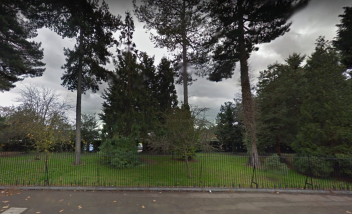
- “St. Andrew’s Hospital” – See map above. This hospital, and its inhabitants, are focused on in the chapter Round the Bend.
- “where they’d kept John Clare for more than twenty years” – Clare was an inmate from 1841 to his death in 1864.
- “circus-turn” – Probably “skit, comedy routine”.
paragraph 4
- “former grammar school boy” – Arnold did attend Northampton Grammar School.
- “former inmate of St. Andrew’s” – From 1979-1983.
- “when it was Northampton General Asylum” – Actually, the Northampton General Lunatic Asylum.
- “Tower Street” – Where Perrit now lives, see P207p2.
- “Elysian” – Heavenly.
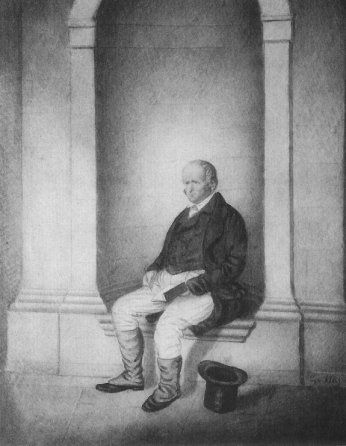
John Clare in the Portico of All Saints’, by George Maine - “take a stroll downtown to sit beneath the portico of All Saints’ Church” – As John Clare often did from 1841-1845 (after which a new administrator confined him to the asylum grounds), see image.
- “a literary benefactor” – The Hon. George Wentworth-FitzWilliam paid most of Clare’s expenses (including, eventually, his funeral expenses).
Page 233
paragraph 1 (continued)
- “be somebody else, be Queen Victoria’s dad, or Byron” – Both of these are delusions that Clare had at various times.

Lucia Joyce in her mermaid costume.
paragraph 2
- “Misogynist and poet J.K. Stephen” – 1859-1892. A character in the chapter Round the Bend. (I think his misogyny is largely an invention of Ripperologists.)
- “Dusty Springfield” – 1939-1999, English singer. Another character in Round the Bend.
- “Lucia Joyce” – 1907-1982. Viewpoint character of Round the Bend.
- “arrived here […] in the late 1940s” – Inaccurate. Joyce had a brief stay in St. Andrews in the winter of 1935-1936, then was an inmate from 1951 until her death in 1982.

Lucia Joyce’s tombstone - “Kingsthorpe Cemetery” – Lucia Joyce is buried here, see image.
- “a few feet from the gravestone of a Mr. Finnegan” – See Round the Bend, P919p2.
- “I Just Don’t Know What To Do With Myself” – A 1962 song by Burt Bacharach and Hal David. Dusty Springfield recorded a hit version of it in 1964.
paragraph 3
- “Samuel Beckett” – 1906-1989, Irish writer. He is talked about in the chapter Round the Bend, and appears in the chapter The Steps of All Saints.
- “Dave Turvey” – Previously mentioned at P216p1.
- “Tom Hall” – See P219p2.
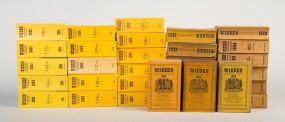
Wisden Cricketers’ Almanac for 1947-2006 (www.carters.com.au) - “Wisden’s Almanac” – An annually published reference book known as “The Bible of Cricket“.
- “the County Ground” – A cricket venue in the Abington neighborhood of Northampton (NE of the Boroughs).
paragraph 4
- “Cliftonville” – See map below, center bottom.
- “riding into the sunset” – A common image at the end of movies, especially Westerns.

Page 234
paragraph 1 (continued)
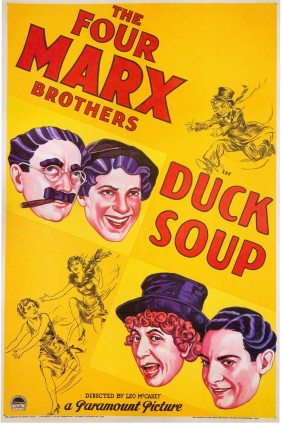
- “Duck Soup” – A 1933 Marx Brothers film, considered by some (including me) to be their finest.
- “Zeppo and Harpo” – Zeppo is the least memorable of the Marx Brothers, generally playing the “straight man”. Harpo is silent (quite unlike Perrit), but is full of irrepressible chaos and jokes. Harpo is also the only Marx Brother to display artistic talent in his screen persona; he is only calm when he plays the harp (beautifully).
- “Toyland” – Possibly a reference to the 1903 operetta (adapted to a book in 1904, and films in 1934, 1961, and 1977) Babes in Toyland. Possibly a reference to the setting of Enid Blyton’s Noddy books. (which Moore used in The League of Extraordinary Gentlemen).
- “Where the Billing Road concluded […] along Spencer Parade.” – See map above.
paragraph 2
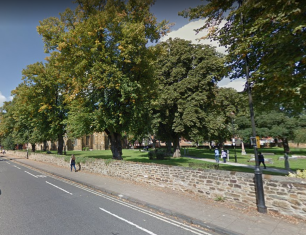
- “St. Giles churchyard” – See map above and image right.
- “the town map for 1610” – I’ve seen other dates for this map, 1611, 1614. A copy can be seen below.

1614(?) map
paragraph 3

- “Co-op Arcade” – See image right and map below.
- “its redundant upper reaches gazing bleakly onto Abington Street” – I’m not quite sure what is meant here. The very top of the frontage of the Co-op is merely decorative, and hypothetical eyes there would be able to see the two blocks north to Abington Street.
- “the Wig & Pen” – See map below. Moore also discusses this pub briefly in the Voice of the Fire chapter Phipps’ Fire Escape.

Ben Perrit’s walk, part 12 (Google Maps 2021) - “Elliot O’Donnell” – 1872-1965, English author and “ghost hunter”. While I have found several places where he mentions Northampton hauntings, I have been unable to find any about the Black Lion specifically.
Page 235
paragraph 1 (continued)
- “ploughman’s lunch” – A traditional English meal of bread, cheese, onions, and other ingredients.
paragraph 2
- “broad imperial steps […] soaring crystal palace […] Dan Dare cathedral” – Seriously exaggerated description of the Guildhall, see picture below. Dan Dare was a British science fiction comic strip which originally ran from 1950-1967.

The Guildhall (Google Street View Aug 2016) - “the old Labour Exchange in Grafton Street” – Mick walked past this building in the chapter Work in Progress, P26p3. There it was compared to an “abbatoir”.

Alan and Melinda leaving the Guildhall (neilgaiman.com) - “countless civic weddings” – Alan Moore and Melinda Gebbie were married at the Guildhall on May 12, 2007.
paragraph 3
- “the forgotten Mayorhold” – Mentioned frequently throughout Jerusalem. The square dates back to at least the early 1600s. Now marked only by a parking garage.
- “at the foot of Abington Street” – The documentation I’ve found says it was “on the corner of Abington Street and Wood Hill”, hence about 200 feet NW of the current location.
- “Ben looked up […]” – See image.

Looking up at St. Michael (Google Street View Apr 2019) - “the saints, who, unless Ben had got it wrong, were human beings” – Ben has got it wrong. “Saint” is a translation of the Latin “sancta”, meaning “holy” (or “holy one”). Some good people are holy, and the good angels are also holy.
- “How had Northampton managed to recruit one of God’s four lieutenants as its patron saint?” – An excellent question. A pamphlet published by the West Northamptonshire Council describes the statue as “St Michael, the Patron Saint of
Corporations”. I have not found other references to this patronage, though there are a few references to Michael being the patron of Bankers. Suggest?
paragraph 4
- “down the north side of All Saints” – Almost crossing his earlier path, see map below. This might be a typo for “the south side”, though, as there seems no particular reason for Perrit to go around three sides of the church.

Ben Perrit’s walk, part 13 (Google Maps 2021) - “Delphic Oracle” – A famous prophet of the ancient world. Unclear why Clare would be compared to a prophet.
- “he waited at the lights to cross Horsemarket” – Perrit is at the corner where the chapter Modern Times was set. See map below.

Ben Perrit’s walk, part 14 (Google Maps 2021)
Page 236
paragraph 1 (continued)
- “a pilgrim from Golgotha” – See the chapter X Marks the Spot.
- “rood” – An archaic word for “cross”.
- “it wasn’t only Benedict who thought that. It was God who thought that too” – Alan Moore has frequently made variations of this joke in interviews.
paragraph 2
- “a miracle in the eleventh century” – This forms much of the subject matter of the Voice of the Fire chapter November Saints.
paragraph 3
- “damp pantalooned” – Implying incontinence, but “pantaloon” has a further association with elderly, comic theater characters.
Page 237
paragraph 1
- “The surviving lower reaches of a factory wall that dribbled down as far as Gregory Street” – Looking at Google Street View, this wall does not seem to have survived into 2009.
paragraph 2

- “byres” – Cattle barns.
- “Santorini” – A Mediterranean island that experienced one of the most devastating volcanic explosions in history, about 3,600 years ago. This has led some to believe that it may be at the roots of the legend of Atlantis.
- “McAlpine” – Probably referring to the Sir Robert McAlpine Limited construction company.
- “Jimmy’s End and Semilong” – Two Northampton neighborhoods, located respectively west and north of the Boroughs.
- “King’s Heath and at Abington” – Two more distant neighborhhods. King’s Heath is about 1.7 miles NNW of the Boroughs, while Abington is about 1.3 miles NE. Alma Warren lives in Abington in 2006.
- “beached former resident, flopping and gasping” – Comparing these residents to whales or fish, dying without water.
- “antediluvian” – A somewhat archaic word meaning “before the flood”. This usually refers to the Biblical flood, but here it continues the imagery of redevelopment as flood.
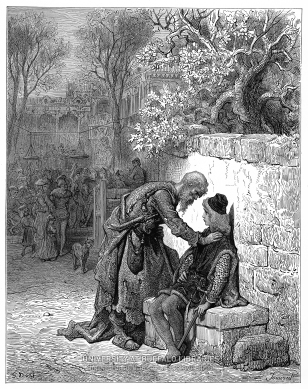
The Ancient Mariner telling his tale (Gustav Dore, digital.lib.buffalo.edu) - “Ancient Mariner” – From Samuel Coleridge’s 1798 poem, “The Rime of the Ancient Mariner“. The Mariner is the lone survivor of a shipwreck, who tells the tale of his cursed voyage.
- “Ishmael” – Narrator of Moby Dick, another lone survivor of a shipwreck telling the story leading up to that wreck.
- “Plato” – Athenian philosopher of the Classical period. In this context, he is the originator of the legend of Atlantis (originally an allegory, not a history).
- “bricked up entrance to the medieval tunnel system in his cellar” – There are medieval tunnels under Northampton, though there is debate as to how extensive they are.
- “The horse that brought his dad home every night” – See chapter Rough Sleepers, P102p3.
- “deathmongers” – For much more on these, see the chapter The Breeze That Plucks Her Apron.
paragraph 3
- Here we begin replaying the scene from the chapter ASBOs of Desire, P80p1ff, from Perrit’s point of view.
paragraph 4
- No notes.
Page 238
paragraph 1
- “half-caste girl, what they called nowadays mixed race” – The term “half-caste” was becoming increasingly seen as offensive at this time.
- “looked to be in her mid or late twenties” – See paragraph 6 below.
- “Eden” – The Biblical paradise from which Adam and Eve were expelled.
- “Undine” – A water-fairy. The word is applied to the Nene Hag later in Jerusalem.
- “Lemurian” – Lemuria is another mythical sunken continent.
paragraph 2
- No notes.
paragraph 3
- “pear drops” – A kind of British candy.
- “some suppressed contortions” – Marla is trying not to laugh (P80p6).
- “kismet” – “Fate” or “destiny”. Originally from Turkish and Urdu. Popularized in English by a 1911 play, and subsequent film adaptations.
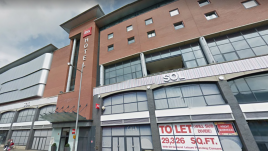
ibis Hotel seen from Freeschool Street (Google Street View Sep 2014) - “ibis hotel” – See map above, image right. The lower- case “I” in “ibis” is not a typo, but how the chain spells the word.
- “Dr. Martens” – A popular brand of boots and shoes, more commonly referred to as “Doc” Martens. The text is not 100% clear whether the boots are on his or her feet, though I lean towards hers.
- “Sheba” – The Queen of Sheba was a Biblical figure at the time of Solomon, renowned for her beauty and power.
- “Maybelline-drenched petals” – Excessively-ornateway of saying “heavily made-up lips”. Maybelline is a brand of makeup.
paragraph 4 – 5
- No notes.
paragraph 6
- “revised his estimate from mid/late twenties down to mid/late teens” – Marla is actually 19 years old (P67p2).
Page 239

paragraph 1 (continued)
- “Hugh Grant” – An English actor known for playing romantic roles, primarily of middle or upper class characters.
- “nightmare clans like the O’Rourkes or Presleys” – Suggest??
paragraph 2
- “villanelles and throwaway sestinas” – Villanelles and sestinas are both complex forms of poetry which were popular among 19th century English intellectuals.
- “Ealing” – A London movie studio, best known for its comedies from roughly 1948-1955.
paragraph 3

- “Mr. Pickwick” – The primary protagonist of Charles Dickens’ The Pickwick Papers, a retired businessman.
- “a mudlark selling dildos” – A mudlark is someone who searches shorelines for valuable detritus when the tide goes out, especially the shores of the Thames River in London. If they are selling scavenged dildos, that would be pretty shocking!
paragraph 4 – 6
- No notes.
paragraph 7
- “plank, paste-bucket and banana skin” – Traditional props for slapstick comedy.
Page 240
paragraph 1 (continued)
- No notes.
paragraph 2

- “John Falstaff” – A comedic character from Shakespeare. Falstaff is quite stout, and usually played with a deep voice, quite the opposite of a “gangly tenor”.
paragraph 3
- No notes.
paragraph 4
- “Cromwell House” – More properly Hazelrigg House, see chapter Sleepless Swords, Pxxxff.
paragraph 5
- No notes.
paragraph 6
- “cladding” – somewhat old-fashioned word for “covering”.
Page 241
paragraph 1 (continued)
- “tell his sister “Don’t go out tonight”” – Ben’s sister died in an accident in 1966 (see P207p2).
- “meniscus” – A liquid surface curved by surface tension.
paragraph 2
- “chippy” is British slang for a fish-and-chips shop. Probably referring to The Golden Fry, a few blocks from Perrit’s house.
- “St. Andrew’s Street” – Not to be confused with the oft-mentioned St. Andrew’s Road.
- “Darwin and Elizth Fry” – See notes to P216p1-2.
- “Gregory Street” extends east of Freeschool Street, at approximately the location of Perrit’s childhood home.
- “Chatterton” – Probably referring to Thomas Chatterton (1752-1770), an influential English poet who committed suicide at age 17. “Golden hair” is rather puzzling; most images of Chatterton show him with dark hair. A famous 1856 painting by Henry Wallis shows him with bright red hair, though in some reproductions one might call it red-blond.

Chatterton 1856 by Henry Wallis (www.tate.org.uk)
paragraph 3
- “Bird In Hand on Regent’s Square” – See map. Ben is over a third of a mile NNE from where he was last paragraph, having passed at least close to home in the interim, though obviously not staying in. (At some time prior to 2009, this pub changed its name to “Edge of Town“.)
paragraph 4
- “15-denier” – Denier is a measure of thread weight in hosiery. A 15-denier stocking is “sheer”.
- “like chess knights with concussion, waltzing mice with Tourette’s” – A rapid-fire set of images, all meant to evoke a drunken stagger. Chess knights move two spaces in one direction, then one space at 90 degrees to that direction. A waltz is a dance in which the basic step is forward, to one side, back, though the couple normally progresses in a spinning motion across the dance-floor. Waltzing mice are a type of Japanese mouse with a birth defect that causes it to move around in an apparently drunken manner. Tourette’s Syndrome, while commonly associated with verbal tics, also commonly includes physical twitching.
- “bottling” – The act of hitting with a bottle, something which can only be perceived as “well-intentioned” by someone whose judgment is severely impaired.
- “it wasn’t even closing time. There was no closing time.” – Starting in the 19th century, there were restrictions on what hours UK pubs could be open. However, these restrictions were lifted in 2005. Closing time had been at 23:00, so we are now well past that time.
- “ostensibly to somehow cut down on binge drinking” – Per Wikipedia: “the new law’s defenders have claimed that the relatively early 23:00 closing time […] contributed to binge drinking, as patrons hurried to drink before closing time.”
paragraph 5
Page 242
paragraph 1 (continued)
- “the riotous sunset of his waistcoat” – Marla described it earlier (P80p2) as “all sort of orange yellow red whatever”.
paragraph 2
- “Elizth Fry” – That is, a five-pound note (see P216p2).
- “publican” – A somewhat old-fashioned word for a bartender.
paragraph 3
- “He turned right” – Immediately turning away from his stated destination of home. Perrit takes a roundabout route home overall, far from the quickest one. But he does so in order to intersect with some other events of note, see below.

“trolls on pencils” - “traitors’ skulls were placed on spikes” – See the Voice of the Fire chapter Confessions of a Mask.
- “trolls on pencils” – A type of Troll doll. See image.
- “witches had been burned” -See the Voice of the Fire chapter Partners in Knitting.
- “a nightclub painted lurid lavender” – See image. It appears to have been painted over sometime between 2009 and 2012.

“a nightclub painted lurid lavender” (Google Street View Apr 2009) - “Macbeth’s” – Presumably named after the Shakespeare play.
- “Coals to Newcastle, wolfbane to Transylvania” – Newcastle was a well-known coal-producing area. Hence “coals to Newcastle” became proverbial for adding something uselessly to an already abundant supply. “Wolfbane to Transylvania” extends the idea to classic horror movie tropes. Transylvania is infamously a haunt of vampires and werewolves. While wolfbane (or wolfsbane) is a real plant, in this context it can be taken to refer to the faux-folk usage of it in the early Universal horror movies Dracula and The Wolf Man. For more discussion of how Northampton is connected to goth subculture, see the chapter The Rood in the Wall, P1121p2ff.
- “Grafton Street” – Noted on the map below as A428.

Ben Perrit’s walk, part 15 (Google Maps 2021)
paragraph 4

- “the solar logo of the Sunlight Laundry” – Mick Warren walked by here in chapter Work in Progress, P26p3. See image.
- “piss-yellow sodium light” – From the mid-20th century to the early-21st, sodium-based yellow street lights illuminated most streets at night. By 2006 some areas had already begun replacing these with white LED-based lights, but this obviously had not yet happened in Northampton.
- “below the yard arm” – In contrast to the saying “The sun is over the yard arm“, meaning that it is time to begin drinking. The phrase is originally nautical in origin, from the 19th century, referring to the first rum ration of the day being given out at 11:00 A.M.

Site of the Grafton Street wreck (Google Street View Apr 2009) - “There was a wreck recovery going on” – See map above and image right. The wreck itself will be depicted in the chapter Go Now See This Cursed Woman, Pxxx.
- “presumably they had been flung from a burst-open boot” – True, see Pxxx.
Page 243
paragraph 1 (continued)
- No notes.
paragraph 2
- “Worse thing is, it’s not even supposed to be my shift tonight.” – Presumably, the victim of the car crash might disagree about this being a “worse thing”.
paragraph 3
- No notes.
paragraph 4
- “Ask not for whom the bell tolls” – A reference to John Donne‘s 1624 work, Devotions upon Emergent Occasions, which includes the famous words:
No man is an Iland, intire of it selfe; every man is a peece of the Continent, a part of the maine; if a Clod bee washed away by the Sea, Europe is the lesse, as well as if a Promontorie were, as well as if a Mannor of thy friends or of thine owne were; any mans death diminishes me, because I am involved in Mankinde; And therefore never send to know for whom the bell tolls; It tolls for thee.
- “Joy rider” – Someone (usually young) who steals a car temporarily, just for the joy of riding it. This practice started dying out after the year 2000, due to improved security systems protecting cars from theft.

Police in high-vis jackets (Photo: Jeff J Mitchell / Getty Images) - “sherbet lemon police-issue waistcoat” – I have been unable to precisely document the timing of the custom, but police use of high-visibility yellow jackets was becoming ubiquitous by 2006. See image.
paragraph 5 – 9
paragraph 10
- “tart” – British slang “prostitute”.
- “done over” – British slang “beaten up”.
- “down on Andrew’s Road” – Technically the crime occurred near St. Andrews Road, not on it, and the victim has been taken in by the dweller at the corner of St. Andrews and Scarletwell Street; see chapter Go Now See This Cursed Woman.
paragraph 11
- No notes.
Page 244
paragraph 1 (continued)
- “It would be one just like her” – Ironically, it is the precise same girl.
paragraph 2
- “The spate of sexual abductions and attacks […] last August” – See notes to chapter ASBOs of Desire, P69p4ff.
paragraph 3
- “Herbert Street” – See map.

Ben Perrit’s walk, part 16 (Google Maps 2021) - “Lucozade-toned darkness” – Lucozade is a British energy drink with a yellow-orange color. Probably referring to the yellow glare (possibly reflecting off clouds) from the sodium streetlights (see P242p4 above).
- “Stanley Kubrick monoliths” – In the 1968 Stanley Kubrick film 2001: A Space Odyssey, aliens visit Earth in the distant past, and leave behind a black rectangular object (commonly called a monolith). The monolith is strongly implied to lead to the first tool use by the pre-human primates who are near it.
- “the shaggy, louse-bound primitives” – Perrit ironically equates the proto-humans of 2001 with the inhabitants of the Boroughs.
- “Ideas like “Jump”” – Referring to the practice of committing suicide by jumping off of tall buildings.
- “You couldn’t even see […] Spring Lane School from this specific viewpoint […] for all the NEWLIFE standing in the way” – A bit of an exaggeration. While the NEWLIFE buildings block part of the view, much of the remainder is blocked by a wall around the school, and (at this time of year) by tree foliage. See image below.

The view down Herbert Street (Google Street View Sep 2014)
Page 245
paragraph 1 (continued)
- “Simon de Senlis” – The narrator of the Voice of the Fire chapter Limping to Jerusalem.
- “spin-doctor” – “Spin” is a way of biasing reporting to encourage a particular narrative. A “spin-doctor” is a professional media person who specializes in spin.

Uri Geller and spoon (www.urigeller.com) - “spoon-bender” – Uri Geller (1946-) is a famous self-proclaimed psychic. His signature “psychic” move is bending a spoon with his mind. This is largely believed to be a hoax by the scientific community. Hence, the term “spoon-bender” is here used to indicate “deceitful person”.
- “Creationist” – While there are various flavors of Creationism, the most well-known one holds that God created the Universe roughly 6,000 years ago, and all evidence to the contrary is either fake, or planted by God for ineffable reasons.

A typical greengrocers’ apostrophe (www.theguardian.com) - “greengrocers’ punctuation” – Misuse of apostrophes (and other punctuation) is rife throughout the retail sector, but grocers are notable offenders, frequently using an apostrophe before a plural “s” (see image). So notable that a 2010 radio drama was titled The Greengrocer’s Apostrophe.
paragraph 2

- “Althorpe Street” – The unlabeled street running east from Simons Walk in the map at right.
- “slaphead” – British slang, with two meanings: “bald” and “annoying person”.
- “Kenny Something’s drug den down at the walk’s end” – This is the most precise description of where Fat Kenny’s place is, and it’s pretty ambiguous. “Down at the walk’s end”would seem to place it at the corner of Simons Walk and Herbert Street; but Perrit is hearing it at the corner of Simons and Althorpe. I’ve split the difference and placed him midway between the two corners.
- “the ochre gloom” – Another reference to the yellow/orange color of the streetlights.
- “car engines vented jungle snarls across the darkening cement savannah” – Comparing cities to jungles is a well-worn image. Moore used similar imagery in his song “Leopardman at C & A“: “zebra cars at dusk drink from a gasoline oasis”.
paragraph 3
- No notes.
paragraph 4
- “tried to gas” – Referring back to his morning fart, P208p2.
- “ton-up” – British slang for high speeds, or persons who are fond of them.
paragraph 5
- No notes.
Page 246
paragraph 1 (continued) – 3
- No notes.
paragraph 4
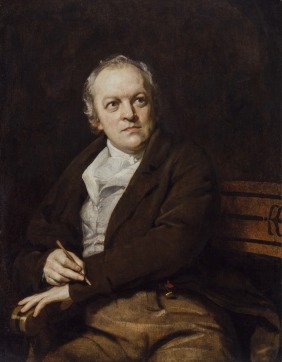
- “William Blake” – English poet and artist, 1757-1827. As described.
- “three-score-and-ten” – 70 years, the traditional length of a man’s life. In Blake’s instance, precisely true. From the Biblical book of Psalms, 90:10: “The days of our years are threescore years and ten”.
paragraph 5
- “bitter-sodden” – Literally referring to a type of beer, but also in the emotional sense.
Page 247
paragraph 1 (continued) – 3
- No notes.
paragraph 4
- One last return to the Spanish Inquisition joke structure Perrit started back in P210p4.
paragraph 5
- “haiku” – Japanese poetry form which is extremely short, consisting of exactly 17 syllables.
- “the mermaid girl” – Ben’s impression of Marla, see P238p1ff.

“clover motifs worked artfully into the head of foam” (Photo by Matt Detrich, http://www.indystar.com) - “clover motifs worked artfully into the head of foam” – See image. Drawing on beer foam is an outgrowth of latte art. It seems to have initially started in the 2000s, and initially been done only on St. Patrick’s Day (hence the shamrock).
paragraph 6

- “bear-baiting” – A blood sport involving forcing a chained bear to fight, popular in England from the 12th through 19th centuries. While Perrit obviously isn’t literally hearing sounds of bear-baiting, his house is located quite close to where Bearward Street once was. While I haven’t found any documentation that bear-baiting was done on Bearward Street, it’s not an unreasonable guess. Moore further supports this idea with a brief mention of a “phantom bear from Bearward Street” in the chapter Malignant, Refractory Spirits, Pxxx.
- “snow-blind” – Snow blindness is a type of eye damage caused by sunlight reflecting off of white snow. It’s an evocative way to describe the whiteness of a yet-to-be-written-on page.
I have been informed that in emails I use the word “haha” too often (and I know I’ve been doing that here too). Ben’s use of “Ah ha ha ha” in this chapter has made me really self conscious about that…haha(?).
DATE = MAY 26, 2006
• This is the same day as Ch3.
P.O.V. CHARACTER = BENEDICT “BEN” PERRIT.
• 52 years old, lives on Tower Street (formerly Scarletwell Street), and grew up on Freeschool Street.
• His sister, Alison, died in a motorcycle “bike smash” over forty years ago.
• He lives with his mother, Eileen.
• His father, Jem, has passed away. (Is Jem the same guy who, in Ch4, his horse would carry home as he slept?)
• He is noted to be attending Alma’s art show on the last page of Ch1.
OBSERVATIONS AND QUESTIONS:
• Page 211, par 4: This is Kenny, the dealer guy from Ch3 whom Marla kind of knows (he also shows up on page 245, par 2).
• Page 212, par 3: Ben thinks his grandfather, Bill “the Sheriff” Perrit may have been one of the Mayorhold mock mayors.
• Page 213, par 2: Roman Thompson appearance. This also mentions that politician James Cockie was on the Bedford Housing Board. Is this a real guy? And is he the dreamer in his underpants in Ch4?
• Page 220, par 2, powerful line: “Rather than try to stop the rot, the council had allowed the town’s main veins to atrophy and wither.”
• Page 220, par 3: “…the murder of hoodies flocked on Abington’s further edge…” A group of crows is called a “murder.”
• Page 226, par 4: Is “Androgyne” an analog for Moore’s (I think) 1970s underground magazine “Embryo?”
• Page 227, par 2: “Clare, who’d hobbled eighty miles from Essex back home to Northamptonshire, would probably have laughed at him.” Moore appeared in a film called By Ourselves that is about Clare taking this hobble. Here’s Moore talking about Clare and the film (https://www.youtube.com/watch?v=hZELY_l6mFs).
• Page 230, par 4: Ben finds himself “just down from what had once been the Boy’s Grammar School.” I live in the same small town I grew up in, and have many times walked across the parking lot that was once my and my sister’s preschool (there was a building there at the time, of course). I’ve been on board with Moore’s “psychogeography” concept since reading From Hell and interviews in which he has discussed the concept in the late 1990s (I believe the idea is inspired by or at least concurrent with Ian Sinclair’s ideas). It looks like Jerusalem will take this idea exponentially further (I know that’s not exactly a secret or anything, it’s just this quick line really got me!).
• Page 232, par 1: David Daniels, noted here as being a childhood friend of Alma’s and Ben’s, a grade above them. He is noted at the end of Ch1 as attending Alma’s art show.
• Page 235, last par: The stone brought to Northampton by the monk in Ch5 is mentioned.
• Page 237, par 2: Tragic and thematic line: “That half-a-square mile continent had sunk under a deluge of bad social policy. First there had been a mounting Santorini awareness rumble of awareness that the Boroughs’ land would be more valuable without its people, then came bulldozers in a McAlpine tidal wave.”
• Page 242, par 3: “This was where the traitors’ skulls were placed on spikes like trolls on pencils, as a decoration.” Heads on spikes are noticed by the monk in Ch5. Also, if this is a reference to the little troll doll heads that kids would put over their pencil erasers back in the day (or maybe that was just a U.S. thing, and probably not Ben’s generation), then that’s really funny.
“EINSTEINIAN BLOCK UNIVERSE” MOMENT:
• Page 224, par 4, at the end of Ben and Marla’s chat: “By mutual consent they seemed to both be disengaging from the conversation, starting to move slowly off, him uphill, Alma down. It was if they’d come to the predestined end of their encounter and must both now walk away, whether they’d finished talking yet or not. They had to hurry if they wanted to remain on schedule, occupying all the empty spaces in their futures they had yet to fill, all the proper predetermined times.”
FUNNY ALMA WARREN DESCRIPTIONS:
• Page 220, par 4: “Even back then, you’d never have confused her with a girl. Or with a boy, for that matter. She was too big, too single minded, too alarming to be anything but Alma, in a gender of her own.”
• Page 221, par 1, Alma had: “…more rings underneath her eyes than on her ostentatiously embellished fingers.”
• Page 222, par 4: “Alma’s voice wasn’t just deep brown, it was infra-brown.”
THESE LINE MADE ME LAUGH:
• Page 207, par 1: “…mermaids mermering…”
• Page 231, par 2: “Anyone applying for their son to be accepted had to first compose a modest essay stating why, precisely, at the most profound ideological and moral level, they believed their child would benefit from being tutored in an atmosphere of strict gender apartheid.”
• Page 232, par 2: “There’d be established foetal standards soon, so that you could feel pressurized and backwards if your fingers hadn’t separated fully by the third trimester. Academic stress-related pre-birth suicides would become commonplace, the depressed embryos hanging themselves with their umbilical chords, farewell notes scratched on to the placentia.”
LikeLike
I’ll put my dramatis personae and index lists here.
NOTES:
Page referrers are for 3 volume paperback edition by Knockabout.
Dramatis personae-characters in brackets are only mentioned but not in scene.
Dramatis Personae
• Benedict Perrit, *1953, POV, drunkard, unemployed poet with writers block
• (Alison, Benedicts sister, died 40 years ago in motorcycle accident)
• (Old Jam, Benedicts father)
• (Lily, Bens wife, left him and took boys—how many—with her)
• Eileen, Benedicts mother
• Fat Kenny
• (Bill Perrit ›The Sheriff‹, Benedicts paternal grandfather)
• (Roman Thompson)
• (James Cookie, former Labour councillor)
• (Botteril, news agent)
• (Butcher)
• (Phyllis Malin, barber)
• (Georgie Bumble)
• barman of Bear pub
• (Dave Turvey, Bendeicts friend with whom he can talk about literature)
• (Pete Corr, ›Piet de Snapp‹, photographer who took Bens portrait, moved to Canada)
• Alma Warren
• (Miss Corrier, teacher at Spring Lane School)
• (Pitt-Draffen, dance school owner)
• (Tattooed couple, Benedicts neighbors after Lily left him)
• (child, injured by young Benedicts attempt to fish)
• (Davis Daniels)
• (racist math teacher in grammar school)
• (legendary monk who brought stone cross from Golgotha to St. Gregory Church = Peter from X Marks the Spot)
• Marla (see chapter ASBOS Of Desire)
• four or five drunk girls, boys
• tow truck men at crash site
• cherub like police officer at crash site
• some bloke in late 30, driver of crashed car
• (wife of accident driver)
• (girl at St. Andrews Road who got raped and beaten = Marla?)
• (boyfriend of Alison, died with her in accident)
Index
• ›Foul fanthoms five his farter lies, and office bones are cobbles made‹, play on ›Full fathom five thy father lies; of his bones are coral made‹, Ariel`s Song from The Tempest by William Shakespeare: 205
• Dylan Thomas (1914-1953), Welsh poet: 206, 224
• H. E. Bates (1905-1974), English writer and author: 206
• John Clare (1793-1864), English poet: 206, 213, 223, 225, 227, 230, 232, 241
• Thomas Hardy (1840-1928), English novelist and poet: 206
• Old Spice, brand name for after shave: 207
• The Clitheroe Kid, BBC comedy radio show (1957-1972): 207
• Benson & Hedges, cigarette brand: 208
• Carlsberg, beer brand: 208
• A Northamptonshire Garland, anthology (1989) by Trevor Hold: 208, 213, 224
• Trevor Hold (1939-2004), English composer and writer: 208
• Fortean Times, british monthly magazine about strange phenomena: 209
• Calpol, pharma product for infants and children: 209
• Brooke Bond, tea brand name: 209
• I`m Not In Love, song by 10CC (1975): 209
• Lego: 209
• Henry Lee ???: 209
• Richard the Second (1367-1400), also theatre play by William Shakespeare: 209
• Titchbourne Claimant, legal identity case in Victorian England concerning missing heir to Tichborne baronetcy: 210
• The Great Pretender, song by The Platters (1955), covered by Freddie Mercury (1992): 210
• Lambert Simnel (1477-1525), pretender to the throne of England: 210
• Perkin Warbeck (1474-1499), pretender to the throne of English: 210
• ›Ford Transit Gloria Mundi‹, play on ›Sic transit gloria mundi‹ (Thus passes the glory of the world): 212
• The force that through the green fuse drives, poem (1933) by Dylan Thomas 212
• The Archers, BBC radio soap (1951-present): 212
• Walter Gabriel, character in The Archers, performed by Robert Mawdesley and Chris Gittins 212
• John Smith (money): 213
• Darwin (money): 213, 235
• Elizthe Fry (money): 213, 215, 235, 236
• John Lennon (money): 213
• Dads For Justice = ??? Fathers 4 Justice ???, fathers rights organization founded in 2002: 213
• Thomas Grimshaw (1836-1893), English painter: 213, 214
• Humpty Dumpty, character in Alice in Wonderland by Lewis Carroll: 214
• ›no one there to put him back together‹, see Alice in Wonderland by Lewis Carroll: 214
• Stars In Their Eyes, British talent TV show: 214
• Matthew {Kelly}, presenter of Stars in Their Eyes from 1993-2004: 214
• Aubrey Beardsley (1872-1898), English illustrator and author: 214
• Hank Janson, fictional thriller character & pseudonym of English pulp fiction author Stephen Daniel Frances (1917-1989): 214
• Dennis Wheatley (1897-1977), English thriller and occult novel author: 214
• {Georges} Simenon (1903-1989), Belgian writer, most famous for his Detective Maigret novels: 214
• Alistair MacLean (1922-1987), Scottish novelist of thriller and adventure stories: 214
• Clock-a-Clay, poem John Clare: 214
• I Am, poem John Clare: 215
• Olivia Newton John, English-Australian singer, songwriter and actress: 216
• Tom Hall (1936), US country music songwriter, singer, novelist and short story writer: 216, 228, 230
• Mars Bar: 216
• Lothario, seducer of women in Don Quixote (1605-1615) by Miguel de Cervantes: 218
• Clearance Area, poem by Benedict: 218, 225
• The Independent, British newspaper: 219
• Edward Elgar (money): 221, 224
• The Dream of Gerontius, work for voices and orchestra (1900) by Edward Elgar: 221
• Emmerdale, British TV soap (1972-present): 221
• Charles Bradlaugh (1833-1891), English political activist and atheist: 221
• {Otto Adolf} Eichmann (1906-1962): German Nazi SS-Lieutenant Colonel; major organizer of Holocaust: 222
• Androgyne, (fictional?) student art magazine: 222
• Andy Warhol (1928-1987), American pop art artist: 223
• Bridget Reily (1931), English Op art artist: 223
• Northampton Chronicle & Echo: 223
• Sir Malcolm Arnold (1921-2006), English composer: 223, 228, 241
• Colonel Bogey March (1914) by F. J. Ricketts: 224
• Tim O`Shanter, nickname for Overture Op. 51a (1955) by Malcolm Arnold, based on poem by Robert Burns: 224
• Under Milkwood (1972), radio drama by Dylan Thomas: 224
• The Angler`s Song: 225
• William Basse (1583-1653), English poet: 225
• Phillip Doddridge (1702-1751), English Nonconformist: 225, 226
• Christ`s Message, poem by Doddridge: 225
• Book of Luke, Bible: 225
• ›He comes the broken heart to bind‹, poem by Doddridge: 226
• Mildmay Fane of Apethorpe, 2nd Earl of Westmoreland (1602-1666): 226
• Julian Henry Charles Fane, 11th Earl of Westnoreland (1827-1870): 226
• John Betjeman, poet, writer, broadcaster (1906-1984): 226
• ›The moss-grey mansion of my father stands‹, quote from Julian Fane. A Memoir (1871) by Robert Lytton, : 226
• Tony Blair, English Prime Minister (1997-2007), Leader of Labour Party (1994-2007): 227
• Queen Victoria: 228
• J. K. Stephen (1859-1892), English poet and tutor to Prince Eddy: 228
• Dusty Springfield (1939-1999), English pop singer and record producer: 228
• Lucia Joyce (1907-1982), daughter of author James Joyce: 228
• Finnegans Wake (Work in Progress), avantgardist comical novel (1939) by James Joyce: 228
• I Just Don`t Know What To Do With Myself, song (1964) performed by Dusty Springfield; famously covered by Dionne Warwick (1966) and The White Stripes (2003): 228
• Samuel Beckett (1906-1989), Irish avant-garde novelist, playwright, theatre director and poet: 228, 229
• Wisden`s Almanac (= Wisdens Cricketers’ Almanac), cricket reference book, published annually since 1864: 229
• Duck Soup, movie (1933) starring the Marx Brothers: 229
• Zeppo Marx (1901-1979), youngest of the five Marx Brothers: 229
• Harpo Marx (1888-1964), the silent one with the harp: 229
• John Speed (1552-1629), English cartographer: 229
• flatland (as expression): 229
• Elliot O`Donnell (1872-1965), English authority on ghosts and hunted places: 230
• Archangel Michael (on Guildhall): 230
• Ivalde, 11th century: 231
• St. Ragener, anglo saxon saint http://www.fostp.org.uk/uploads/St%20Ragener%20%28M%29%20of%20Northampton.pdf : 231
• Holy Spirit: 231
• Atlantis: 232
• ??? Santorini, small greek island or Italian physician and anatomist Giovanni Demenico Santorini (1681-1737): 232
• The Rime of the Ancient Mariner, long poem (1798) by Samuel Taylor Coleridge: 232
• Ishmael, protagonist of Moby Dick (1851) by Herman Melville: 232
• Plato: 232
• Eden, garden of God, Genesis, Bible: 232
• Undine, elemental being associated with water (Paracelsus); water nymph: 232
• Lemuria, fabeld hyothetical continent in Indian Ocean; also: fictional location in Marvel Comics: 233
• Doctor Marten`s, brand name of English shoes, popular with youth subculture: 233
• Sheba, kingdom mentioned in Old Testament: 233
• Maybelline, cosmetic brand: 233
• Hugh Grant, English actor: 233
• ??? O`Rourkes, Presleys, nightmare clans: 233
• Ealing comedy, series of comedy movies produced by London-based Ealing studios between 1947-1957. Most famous may be The Ladykillers: 234
• Mr. Pickwick, character in The Pickwick Papers (1836) by Charles Dickens: 234
• John Falstaff, character in several plays by William Shakespeare: 234
• Thomas Chatterton (1752-1770), English poet: 236
• ›Whom the bell tolls‹, line by John Donne in Devotions upon Emergent Occasions (1624): 237
• John Donne (1573-1631), English poet and cleric: 237
• Lucozade, brand name for energy and sport drinks: 238
• Stanley Kubrick (1928-1999), US movie director: 239
• Simon de Senlis (died 1111), norman knight: 239
• William Blake (1757-1827), English poet, painter, draughtsman and visionary: 240
LikeLike
(girl at St. Andrews Road who got raped and beaten = Marla?) – Most likely Marla’s friend Samantha.
LikeLike
RE Ben’s sister: Moore relates a similar story about a girl on a motorcycle dying in a crash in THE BIRTH CAUL.
LikeLike
I believe the “real life” model for Ben Perrin is the Boroughs poet Dominic Allard: http://www.northampton-news-hp.co.uk/poet-book-published-thanks-old-school-pal-alan/story-25854605-detail/story.html
LikeLike
Dominic Allard is indeed rhe real life Benedict. You can read a selection of his poetry, including “Clearance Area” which is mentioned and quoted in the chapter, here: http://www.bbc.co.uk/northamptonshire/features/poetry_prose/2004/write/dominic_allard.shtml
LikeLike
Perrit, even. Damn typo.
LikeLike
Just for the record, the Tom Hall (1944-2003) referred to was a Northampton songwriter and musician.
LikeLike
Beautiful chapter. I was literally weeping by the end. Very touching.
In general I’m in awe for Moore’s ability to convey all the different voices and inner worlds of the characters.
LikeLike
Ci sono anche dei riferimenti al precedente romanzo di Moore, “la voce del fuoco”, il capitolo 9, “partners in knitting” ed il capitolo 7 “confessions of a mask”
LikeLike
No mention that this par —
“St. Peter’s Church, just up ahead, there’d been a miracle in the eleventh century when angels had directed a young peasant lad named Ivalde to retrieve the lost bones of St. Ragener, concealed beneath the flagstones in the nave, unearthed in blinding light to an accompaniment of holy water sprinkled by the holy spirit who had manifested as a bird. A crippled beggar woman witnessing the incident had risen to her feet and walked, or so the story went.”
— references the story related in “November Saints”, a chapter of Moore’s earlier novel Voice of the Fire? I know it’s based on an existing legend, but was the bird Moore’s invention? It doesn’t seem to be mentioned in what I’ve dug up with a slapdash bit of browsing. If so, is this a cute “crossover” with that novel?
LikeLike
I haven’t yet gotten around to full notes here, but yes, VotF crosses with J in multiple places. FWIW, the mention of a bird does show up in other sources (See closing remarks at https://alanmoorejerusalem.wordpress.com/votf05-november-saints/).
LikeLike
There’s a very good chance that the “Dave Turvey” referenced above was the landlord/licensee of the Black Lion Pub in St. Giles Street until 1986, when he was imprisoned for allowing the sale, use and distribution of drugs on his premises.
LikeLike
So, he was out of prison and hanging out in Northampton pubs by the 2000s? Do you happen to have a name for this person? My google-fu is not strong enough to find any more information based on what you’ve said so far.
LikeLike
Alexx, it was a suggestion. Believe me, having lived in Northampton for many years, mostly the best likely one. His name was Dave Turvey, literally, and he was landlord of The Black Lion. You are over-thinking this.
Alan Moore produced the poster for Turvey’s benefit gig in an attempt to support his release and overturn his conviction.
Jerusalem is not linear
LikeLike
Alexx, I can’t have made myself clear – Dave Turvey was the *actual* name of the licensee of the Black Lion pub. Moore knew him and was involved in organising a benefit gig to challenge his prosecution and support his legal costs (see link below). Turvey was imprisoned in Bedford nick for at least a couple of years, and apparently emerged a changed, bruised man.
I’ve no idea what happened to him after his release as I’d moved away from Northampton by that stage, but I knew him as a passing acquaintance as I frequented the pub regularly.
Link to “Turvey is Innocent” benefit poster hand drawn by Moore: https://glycon.livejournal.com/9207.html
Link to corroborate (about a quarter of the way down, use the page search function for “Turvey”): https://medium.com/@noodlepie/a-side-are-your-dreams-at-night-1985-sizes-too-big-e122596968a0
LikeLike
Sorry it took so long for me to notice your reply. Thanks VERY much for the info!
LikeLike
That’s Beaumont Court as seen from Tower Street. Claremont Court is its sister tower block. Incidentally our house can be seen in the left of the photo, 1 Tower Street.
LikeLike
Thanks for the correction! You being local to Northampton, if you happen to notice any other errors or omissions, I would be deeply grateful if you commented on them.
LikeLike
First off. This blog is amazing. Really adds depth to the books. Thank you so much for doing it.
“mutton dressed up as Olivia Newton-John” – Suggest?? – This plays on the saying “Mutton dressed as lamb” which is basically an old lass dressed as a younger one. It’s not considered a good thing to be labeled mutton dressed as lamb…
The Olivia Newton John bit refers to when she dons a leather jacket and black skintight trousers and takes on a badass persona at the end of Grease.
“Irish Centre” – I’m not sure what an Irish Centre did (suggest??) – An irish centre is typically a type of working mens club that you get here in England catering to the Irish and Irish descendents among us. There’s always a bar and people hire the rooms for family functions and the like. There’ll often be pool tables and darts too. Not entirely different from an irish pub save the decor is generally crapper.
LikeLike